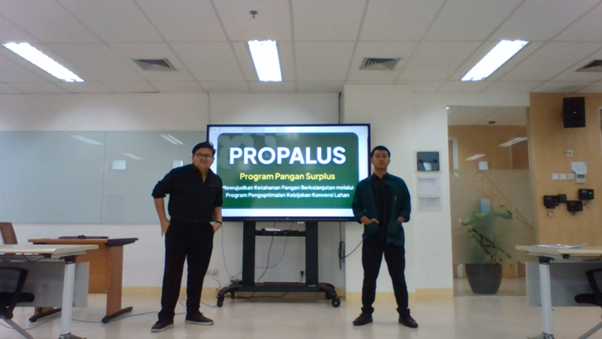Prof. Dr. Aswan’s Scientific Oration: A Long Journey of The Time Traveler in the Perspective of Earth’s History
By Adi Permana
Editor Adi Permana

BANDUNG, itb.ac.id – Faculty of Earth Sciences and Technology (FEST) ITB Professor Prof. Dr. Aswan, S.T., M.T., delivered his scientific oration on Saturday, 22 July (22/7/2023). He presented his oration titled “A Long Journey of The Time Traveler in the Perspective of Earth’s History”.
Prof. Aswan is an ITB Geological Engineering lecturer in the Paleontology and Quaternary Research Group. His passion for undertaking research has led him to the publication of more than 50 papers in the form of books, journals, and proceedings on a national and international level. Prof. Aswan also won numerous awards and even got chosen as an ITB’s Outstanding Lecturer in FEST’s research field back in 2016.
History of the Earth’s Formation
The study of paleontology and historical geology can be connected with the earth's history. However, in his oration, Prof. Aswan mostly discussed about historical geology which correlated with the early formation of earth and its geological aspects.
Prof. Aswan started his oration by introducing the formation of the earth. 4.5 billion years ago, the earth was created as a flaming ball of fire made of incandescent magma that had the same current temperature of the sun. At that time, a lot of objects from outer space fell to the earth, which brought life and water to the planet for the first time.
The earth started to cool down approximately 4 billion years ago and was covered by water vapor from cooling magma. Then, lightning was triggered and the first rain on Earth was formed. This caused the world to turn into a water world because almost 100% of the land was covered with the vast oceanic water.

The First Life on Earth
Around 2 billion years ago, the first signs of life on Earth appeared which was marked by the formation of the vast landmasses in the form of continents. Due to the mass forming of the continents, shallow waters started to develop along the edge of the continents where the sunlight could reach the seafloor. Thus, photosynthetic bacteria algae appeared, and the rest of the metabolism formed oxygen releasing stromatolites as the ancestors of all living things in the world now.
Earth from Time to Time
The continents are constantly interacting with one another. Until 1 billion years ago, they united at the south pole to form the supercontinent Rodinia and kept the warm currents from the equator in the south pole. As a result, 700 million years ago, the earth cooled down and was covered with a thick ice of up to 1.6km. The temperature of the earth dropped to -40°C and became the worst climate calamity ever as well as the first extinction event on Earth. The single-celled living things started to go extinct.
As time went on, the continents moved apart causing the earth to warm up and contribute to global warming due to the greenhouse effect. Because of this, the earth’s temperature started to stabilize 630 million years ago. Among the living organisms that survived and evolved to this day are Trilobites, Mollusks (jellyfish), Euripterids (Scorpions), Cephalaspis, Ortochone (Giant Squids), and Dunkleosteus. This marked the beginning of the Paleozoic era (540-250 million years ago) where life first appeared again.
A few million years later, the continents combined to form supercontinents like Pangea. This implied that 400 million years ago, living creatures started to migrate to the land because the sea’s beginning to dry up, which is when the amphibians began to emerge. Tall plants and giant living creatures started to develop approximately 345 - 280 million years ago, as known as the carbon age. This is caused by the high oxygen level where it frequently rained and made the land fertile.
The Paleozoic era ended 250 years ago due to a mantle plump event in the Siberian continent that caused the second largest extinction event on earth. Magma plump is when a large and hot magma rises through the crust and erupts at the surface. As a result, only dinosaurs and enormous molluscs (ammonites) could survive. The Paleozoic era came to an end and it marked the beginning of the Mesozoic era (250-65 million years ago).
A couple hundreds of years later, another huge event occurred. The Mesozoic era had to come to an end 65 million years ago due to the impact of asteroids and other celestial bodies as thick as Mount Everest that were pouring down the planet. This caused the extinction of dinosaurs and ammonites, and only the mammals survived and entered the Tertiary Age (65 million years ago until present).
“Many experts viewed that the dinosaurs are extremely unlucky because the asteroids can only strike Earth once every 350 million years,” said Prof. Aswan.
Another living creature that could define the time traveler would be the Mollusk. Prof. Aswan said that the ability of Mollusk to survive hundreds millions of years and experience multiple extinction events can serve as solid evidence of the evolution of life on earth.
Besides that, the ability of Mollusk to travel through time makes them important for more advanced research. Prof. Aswan said that he did a couple of research about Mollusks such as Paleogene Mollusks (Paleogeography), studies of sea level changes and ancient climates, studies of tsunamis deposits (Paleotsunami), as well as studies of freshwater mollusks and their association with Vertebrates.
“Everything that we can experience on Earth today is a direct result from the dark ages of the planet. The study of historical geology is able to bring awareness to more people on numerous occurrences on Earth. This may lead people to be wiser in terms of responding to the events happening at the moment,” he concluded at the end of his oration.
Reporter: Pravito Septadenova Dwi Ananta
Translator: Sherina Wijaya (Geological Engineering, 2019)
Editor: Hanna Daniela Ayu (Aerospace Engineering, 2021)

.jpg)

.jpg)
.jpg)
.jpg)
.jpg)

